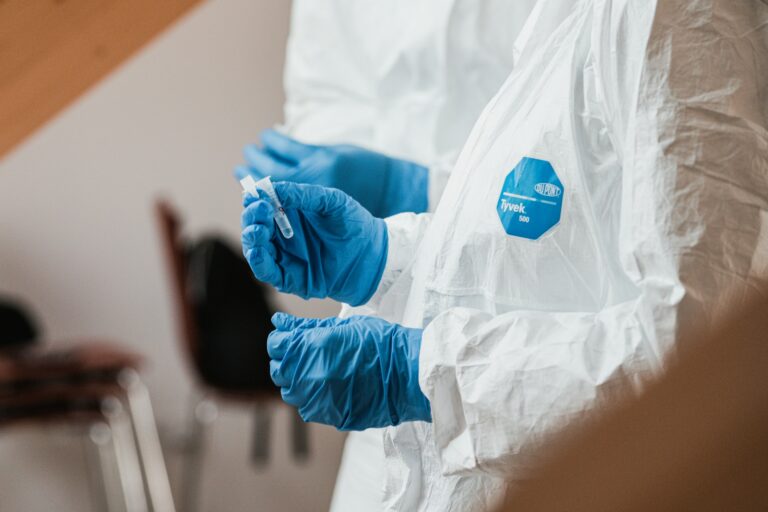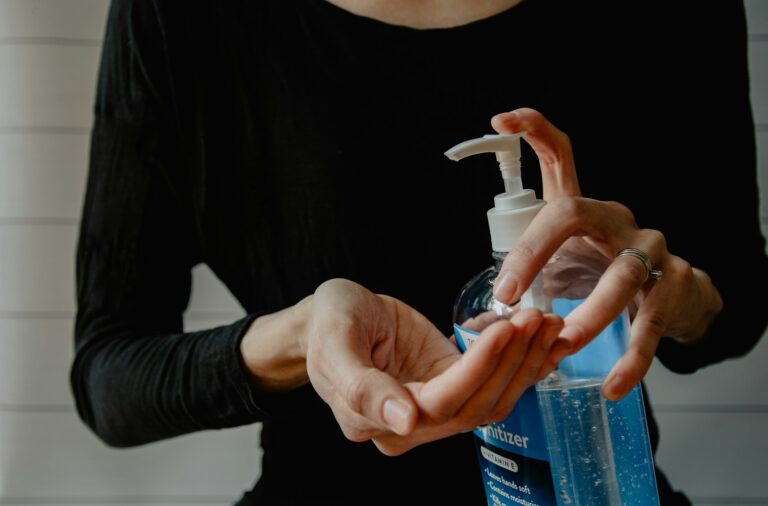Cleaning agents are substances used to remove dirt, grime, and micro-organisms from surfaces and objects. In health and social care, selecting the appropriate cleaning agent directly impacts infection control, patient safety, and the overall quality of care. Each type of cleaning agent targets specific contaminants, environments, and equipment. Using the wrong agent can make cleaning less effective or even unsafe.
In this guide, we will cover the most common types of cleaning agents found in health and social care settings.
Detergents
A detergent is a cleaning solution designed to break down grease, fat, protein, and dirt. Detergents do not kill bacteria or viruses. They simply help to remove them from surfaces by making it easier for water to wash them away.
Where Detergents Are Used
Detergents suit general cleaning tasks:
- Mopping floors in wards and corridors
- Wiping down tables, chairs, and non-clinical surfaces
- Cleaning patient bedrooms, staff rooms, and kitchens
- Routine cleaning of beds, wheelchairs, trolleys, and commodes
Some detergents are suitable for use with specific materials, such as plastics or stainless steel; always follow manufacturer’s guidance.
Disinfectants
A disinfectant destroys or inactivates a large proportion of micro-organisms (such as bacteria, some viruses, and fungi) present on surfaces and equipment. Disinfectants do not clean dirt away, so staff often use them after the area has been cleaned with a detergent.
Types of Disinfectants
- Chlorine-Based Disinfectants: Sodium hypochlorite is the best known. It is effective against most pathogens, including norovirus and Clostridioides difficile. Strong smells and possible corrosiveness mean careful handling.
- Quaternary Ammonium Compounds: Called “quats”, they are good for killing bacteria and fungi, but less effective against some viruses.
- Alcohol-Based Disinfectants: These usually contain ethanol or isopropanol and are mainly used for small surfaces and hand hygiene.
Where Disinfectants Are Used
- Bed frames and mattresses after patient discharge (terminal cleaning)
- High-touch areas such as doorknobs, light switches, and handrails
- Bathrooms and toilets, including sinks and taps
- Surfaces contaminated by bodily fluids (e.g., blood spills)
- Reusable clinical equipment (non-invasive, such as blood pressure cuffs)
Staff often prepare disinfectant solutions fresh each day to maintain their effectiveness. Always check contact time—the required time disinfectant needs to sit wet on the surface to work effectively.
Antiseptics
Antiseptics kill or inhibit the growth of micro-organisms on living tissue, such as skin and wounds. They are not for general surface cleaning.
Where Antiseptics Are Used
- Cleaning the skin before injections, blood sampling, or minor procedures
- Washing minor wounds or grazes
- Hand hygiene in some settings, using antiseptic handwash, especially before surgery
- Cleaning around invasive lines, such as catheters or cannulae
Antiseptics include chlorhexidine, iodine-based solutions, and some alcohol-based products. They lower the risk of infection from cuts, wounds or procedures.
Sanitisers
A sanitiser reduces the number of micro-organisms on surfaces to a safe level, as defined by public health standards. They are less powerful than disinfectants, but work well for areas where deep cleaning is not needed.
Where Sanitisers Are Used
- Food preparation areas, kitchens, and dining rooms
- Cleaning children’s play equipment in care homes or day centres
- Sanitation of communal tables, worktops, and trays
Sanitisers are often used alongside detergents to keep environments safe in non-clinical areas.
Degreasers
Degreasers are powerful cleaning agents created to dissolve thick grease, oil, and fatty residues. Many are alkaline and can be corrosive.
Where Degreasers Are Used
- Kitchens, especially for cookers, extractor hoods, fryers, and floors around cooking areas
- Laundry rooms, especially for greasy stains on fabrics
- Maintenance areas in large care facilities (e.g., floors and equipment in workshops)
Regular use of degreasers in cooking areas helps stop the build-up of fire hazards and keeps food preparation hygienic.
Descalers
Descalers break down mineral deposits, such as limescale, found in water pipes, kettles, washing machines, or taps. They are often acidic.
Where Descalers Are Used
- Cleaning showerheads to keep water flow clear and safe
- De-scaling bathroom taps, toilets, and sinks
- Removing hard water stains from kitchen equipment
By removing scale, descalers improve the efficiency of appliances and help maintain infection control standards.
Abrasive Cleaners
Abrasive cleaners use physical friction, along with chemical action, to tackle stubborn dirt or stains. They often contain gritty materials.
Where Abrasive Cleaners Are Used
- Scrubbing bathroom tiles, grout, and tough stains in toilets
- Removing old marks from sinks and basins
- Deep cleaning non-slip flooring in wet rooms
Excessive use can damage delicate surfaces, so staff typically use abrasives only where necessary.
Solvent Cleaners
Solvent cleaners dissolve substances such as adhesive residues, graffiti, ink, and paint. They often contain alcohols or other chemicals.
Where Solvent Cleaners Are Used
- Removing sticky plasters or tape residue from beds and equipment
- Cleaning up accidental spillage of drugs, dyes, or some cleaning agents
- Dealing with graffiti or mark removal from walls/floors in communal areas
Good ventilation is important when using strong solvents, as fumes can cause irritation.
Enzyme-Based Cleaners
Enzyme cleaners contain biological molecules that break down organic matter such as blood, vomit, faeces, and urine. These are particularly useful for stains and odours.
Where Enzyme Cleaners Are Used
- Cleaning up bodily fluid spills in care home bedrooms or bathrooms
- Removing persistent urine odour and stains from carpets and soft furnishings
- Dealing with incontinence accidents
These cleaners are less harsh than some chemical alternatives, so they suit soft furnishings and areas used by vulnerable individuals.
Wipes and Pre-Prepared Solutions
Wipes are single-use cloths pre-soaked in a specific cleaning or disinfecting solution. They come in various strengths and are convenient for rapid cleaning.
Where Wipes Are Used
- Disinfecting medical equipment such as thermometers, stethoscopes, or blood pressure monitors between patients
- Wiping down bed rails, trolleys, and commodes in clinical areas
- Rapid cleaning in high-risk environments or for outbreak control (for example, if there is a norovirus outbreak on a ward)
Different wipes may contain detergents, disinfectants, or alcohol. They are single-use, so each wipe is disposed of after cleaning one item or area to prevent cross-contamination.
Choosing the Right Cleaning Agent
The selection of the correct agent matches the type of surface, the risk of infection, and the kind of contamination present. Cleaning policies in health and social care settings usually outline which agent staff should use in each scenario. Checking labels before use is always important.
Main factors that influence the choice include:
- The level of infection risk (e.g., high, medium, or low)
- The type of surface or equipment (for example, food-safe, delicate, or medical equipment)
- Whether the area is clinical or non-clinical
- Manufacturer’s instructions and compatibility
- Resident and patient safety (avoiding allergic reactions or harmful residues)
Cleaning is usually a two-step process in high-risk areas: clean first with detergent, then disinfect with an approved disinfectant.
Safe Handling and Storage
Using cleaning agents safely protects both staff and residents. Unsafe use, incorrect dilution, or mixing chemicals can be dangerous.
Safety procedures include:
- Reading and following manufacturer guidelines
- Wearing suitable personal protective equipment (PPE), such as gloves or aprons
- Labeling all cleaning solutions clearly
- Storing chemicals in a locked area
- Keeping chemicals away from food preparation areas
- Never mixing different types of cleaning agents
Staff should be trained to respond to spillages or accidental contact, using first aid or reporting routes in their organisation.
Regulatory Standards
Cleaning standards in health and social care are set by the Care Quality Commission (CQC), NHS guidelines, and sector-specific codes of practice. Products used must be approved for use in health and social care environments.
These standards are designed to:
- Prevent the spread of infection
- Protect vulnerable people
- Comply with health and safety rules
- Help organisations provide a safe, clean environment
Regular audits and inspections make sure procedures are followed.
Staff Training and Accountability
Training equips all cleaning staff to work safely and effectively. Training covers:
- Understanding the types and uses of cleaning agents
- Recognising and handling hazardous substances
- Correct PPE choice and use
- Safe disposal of cleaning materials
- Responding to incidents, spills, or emergencies
Ongoing refresher training and supervision reinforce good habits and ensure consistency across all teams.
Final Thoughts
A wide range of cleaning agents are in daily use across health and social care. The correct choice depends on the surface, the type of contamination, and the infection risk. Knowing when to use detergents, disinfectants, antiseptics, sanitisers, and specialist agents like degreasers or enzyme cleaners keeps people safe and environments healthy.
These practices help reduce healthcare-associated infections, maintain high hygiene standards, and provide reassurance to both staff and service users. By following local policy, guidance, and training, workers contribute directly to safer care and better outcomes.
Subscribe to Newsletter
Get the latest news and updates from Care Learning and be first to know about our free courses when they launch.







